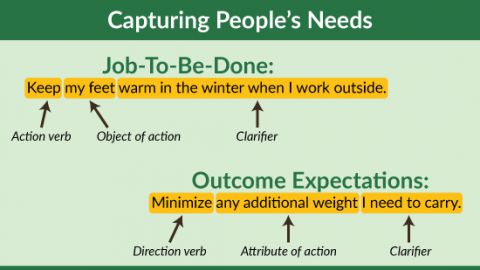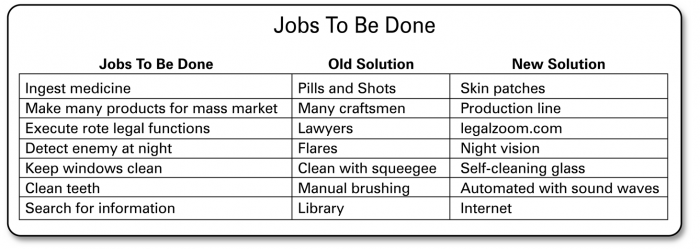What is the Job To Be Done?
The Job To Be Done (JTBD) is a framework for viewing your products and solutions in terms of the jobs customers are trying to get done. In other words, the JTBD is the reason why your customers hire your product or service. It is a starting point for innovation and a critical element when devising strategy.
The concept of the JTBD was developed by Clayton Christensen at Harvard Business School and has emerged as a helpful way to look at customer needs by focusing on their fundamental motivation.
The concept of the JTBD has emerged as a helpful way to look at customer needs by focusing on their fundamental motivation.
Christensen and coauthors articulated the JTBD concept in a Sloan Management Review article, “Finding the Right Job for Your Product” (Spring 2007) as follows:
“Most companies segment their markets by customer demographics or product characteristics and differentiate their offerings by adding features and functions. But the consumer has a different view of the marketplace. He simply has a job to be done and is seeking to ‘hire’ the best product or service to do it.”
For instance, many people would say they buy toothpaste to brush their teeth, and this is true. But if a toothpaste company examines the higher purpose of cleaning one’s teeth and gums, then it might forgo efforts to make a better toothpaste in lieu of developing another product or service that gets the job done better.
Put another way, as Harvard Business School Professor Theodore Levitt famously said: “People don’t want to buy a quarter-inch drill. They want a quarter-inch hole.”
Why Use the Job To Be Done Framework?
If you understand the jobs your customers want done, you can gain new market insights, identify new opportunities and create viable growth strategies. Sometimes a good solution for a JTBD, or a family of JTBDs, does not exist; when this is the case, you have a great opportunity to innovate.
Articulating the JTBD also helps your organization go from an insular perspective to a customer-centric perspective. The process of understanding the customers’ jobs helps you and your teams emotionally connect and develop more empathy for the customer, gaining insight into their struggles and successes while they try to accomplish their jobs.
It also helps breakthrough any psychological inertia, which is the tendency of individuals and teams to stay within the confines of what they know or the paradigm of their industry. By looking at the jobs in a solution-neutral way, teams can consider the ideal state—a hypothetical, imaginary and perfect experience that is free of constraints, compromises and contradictions.
Job Statements
A job statement is a phrase used to describe a JTBD. The key components of a job statement are an action verb, the object of the action, and clarification of the context in which the job is performed. For example, keep my feet warm in the winter when I work outside is a job statement.
Jobs are not solutions. Jobs reflect needs. If a job statement sounds like a solution, you are immediately limiting yourself to some preconceived notion of a product or service that will satisfy the need. Instead, we want to avoid any psychological inertia and open our minds to new innovative possibilities based first on the customer’s JTBD and Outcome Expectations.
Categories of Jobs
There are different categories of jobs—and the better a solution can fulfill these different job levels and layers, the better chance it has in the marketplace.
Functional jobs define the functional tasks we want to accomplish (e.g., brush teeth, floss teeth).
Emotional jobs include the way we want to feel when doing a certain job (e.g., feeling of freshness) or how we want to be perceived by others while performing a certain job (e.g., be perceived as having an appealing smile or fresh breath).
Related or Ancillary jobs describe the related jobs we want to do while accomplishing the main job (e.g., whitening teeth).
Consumption Chain jobs describe upstream and downstream jobs we accomplish (e.g. wipe the sink clean after brushing).
There are many jobs, but not all jobs are equal. For example, the emotional job of being perceived as having an appealing smile may be more important for a customer than the functional job. If you understand the different jobs customers want to accomplish and how customers prioritize them, you can focus on the right customer insights needed to create a product or service that will have a high chance of adoption in the marketplace.
Customer Outcome Expectations
Outcome Expectations (OE) are the metrics customers use to decide which solution to hire when they go through various steps to get the job done.

For example, for the JTBD of keep my feet warm in the winter when I work outside, an OE might be to minimize any additional weight I need to carry. Solutions, on the other hand, could range from heated socks, an insulated shoe, a small portable heating element you slip into any shoe, or shoe material that automatically transforms to a heat producer when in low temperatures.
When identifying JTBDs and OEs, we know that asking customers directly is not a reliable method to accomplish this step. If asked, customers tend to offer ideas on how to tweak an existing product or service, or jump to new solutions. Instead, use ethnography—the science of observing, listening and analyzing the artifacts of customer behavior—to develop hypotheses about the JTBDs and OEs and then validate them with quantitative methods.
The Power of the JTBD
Consider the examples of new solutions for old JTBDs in the exhibit below. Then, ask not how you can make your current products and services better but, instead, ask how you can fulfill your customers’ JTBDs in unexpected and more effective ways.
Before you get to work on developing any innovative solution, you need to first understand what job customers are trying to get done.

